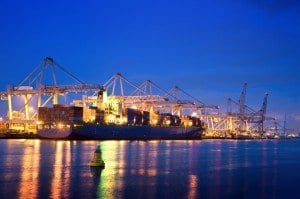Together, Bremen and Bremerhaven make up Europe’s 4th largest container port. Dating back to the ninth century, the port was originally a local river (Weser River) trading post. By the early 1400’s, Bremen/Bremerhaven became an organized import and export trading hub for Northern Europe. The port was first able to accommodate steamships in 1930, which allowed growth for the future. However, the turmoil of World War II stalled the port’s activity for over a decade. In 1957 the port of Bremerhaven began providing roll-on/roll-off (ro-ro) services to handle increased automobile shipping; this in turn helped fuel the burgeoning German automobile industry. The Bremen ports continue to expand and modernize to remain competitive with the ports of Rotterdam, Hamburg and Antwerp.
Facilities:
4 Terminals
14 Berths
Quay Length 3.9 (kilometers)
Operating Area 90 (hectares)
Throughput 2010:
4.9 million TEU’s
Over 48 million tons
More than 1.35 million automobiles
Geography and Climate:
Located in the city-state of Bremen of north-western Germany, the Port of Bremerhaven lies well safeguarded on both banks of the Geest River at the mouth of the Weser. Influenced by the North Sea, Bremerhaven maintains relatively mild winters and comfortably warm summers. . Rainfall is common, however, it usually manifests as a light misty drizzle. The average winter low and summer high is 32 (°F) and 71 (°F) respectively.
Sources:


